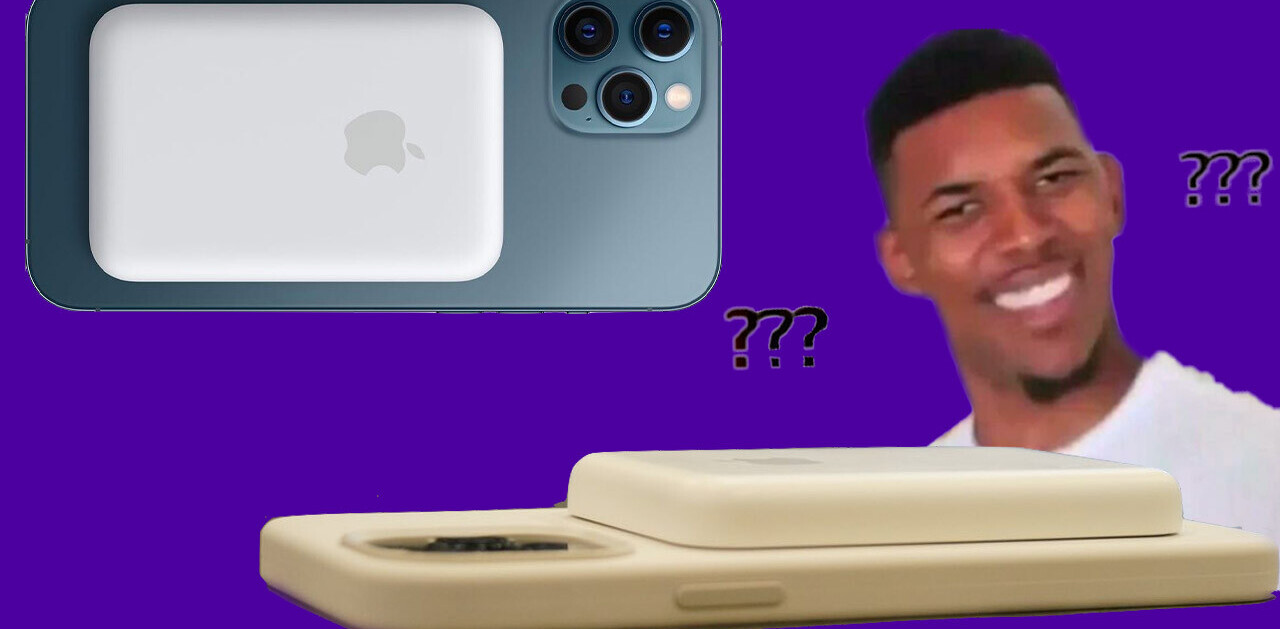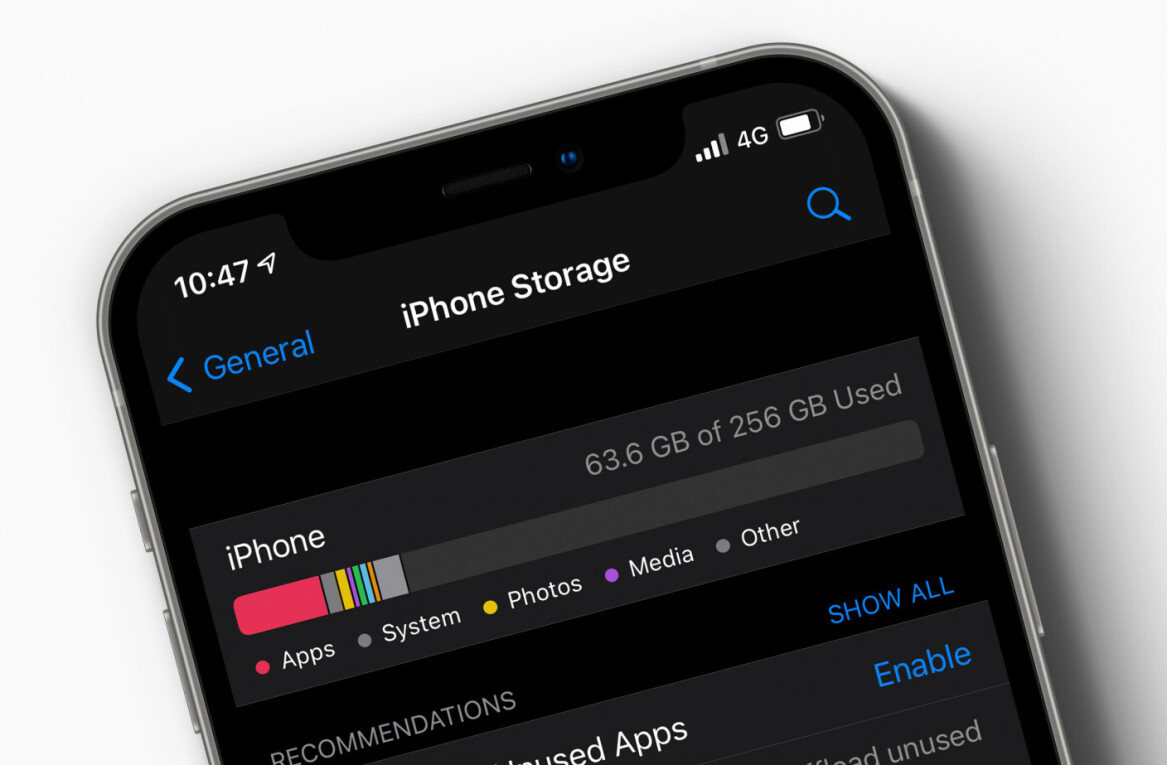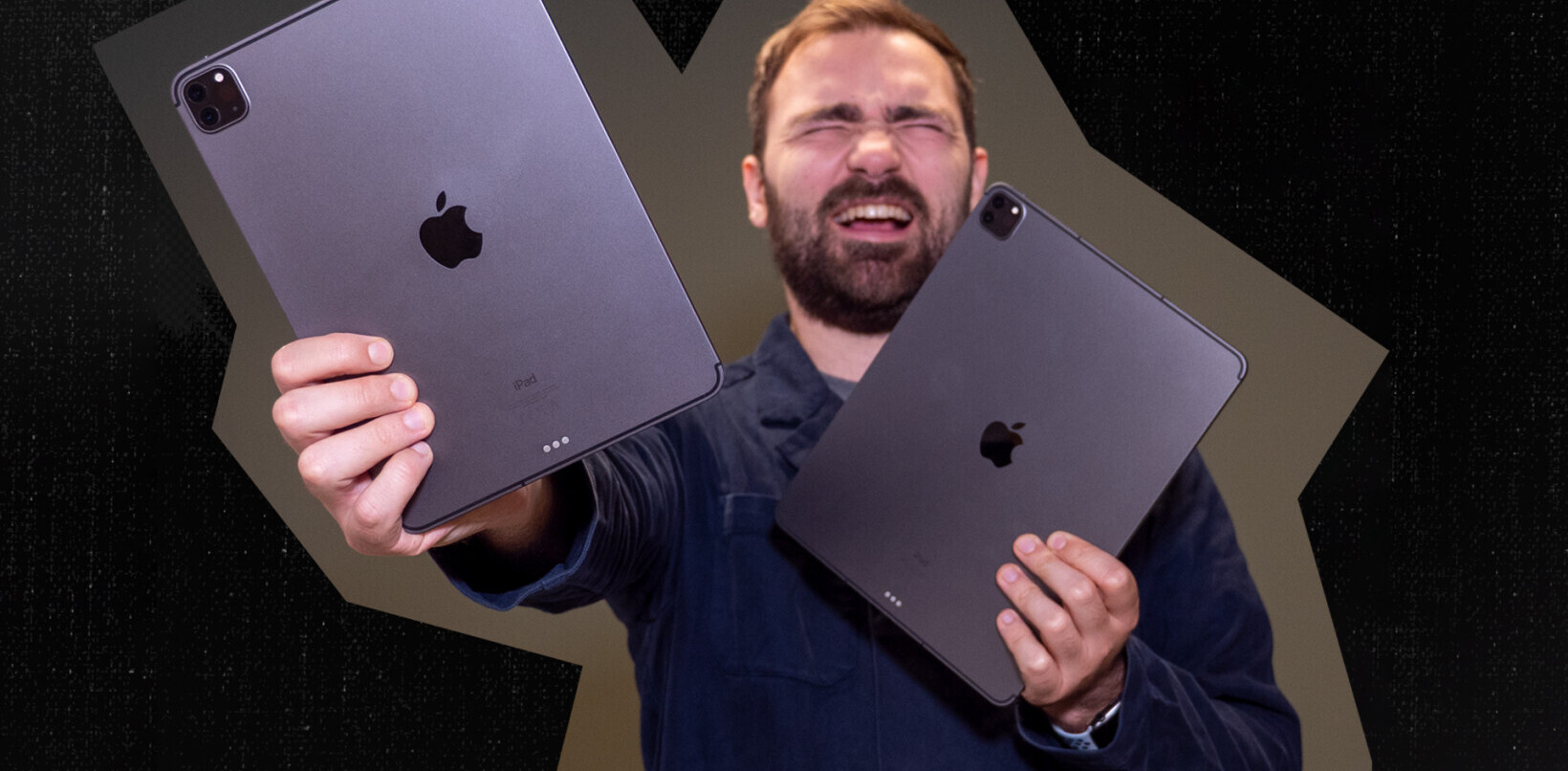
I’ve tested a fair few JBL bookshelf speakers here at TNW. The JBL L82 Classic paired a retro aesthetic with acoustics that emphasized an expansive soundstage, while the HDI-1600 was a more modern take on speaker design with a deep horn/waveguide for focused, sharp imaging.
Well, what if you want both a retro design and a horn-type sound? JBL has a hi-fi speaker for you too: the $2,000 JBL 4309.
Mercifully, unlike so many speakers appealing to retro aesthetics and nostalgia, the 4309 are still solid examples of modern acoustic design. While they aren’t perfect, the speakers maintain JBL’s neutral approach to speaker design with an impeccable spatial presentation.
If you’ve read my review of the JBL HDI-1600, the 4309 sounds a lot like it. I didn’t get to hear the speakers side-by-side, but having heard them both against my longtime reference speaker — the Focal Chora 806 — it’s clear the speakers are more similar than different.
This shouldn’t be too surprising. The speakers share acoustic philosophies, use an identical tweeter (more specifically, a compression driver), and implement similar waveguides that shape the sound for optimal spatial presentation. They both offer 6.5-inch woofers too. But most notably, they measure very similarly.
If you happen to find yourself choosing between these two speakers, I’d just choose whichever you think is prettiest. They are close enough in price (the HDI-1600 retails for $1,800) and performance I suspect they’d be ranked similarly in a blind test. Only JBL, which conducts blind tests for its speakers, knows for sure which is ‘better,’ but the 4309 is priced a little higher.
I’ll let you know which one I think sounds better later in this review. I know, I’m such a tease.
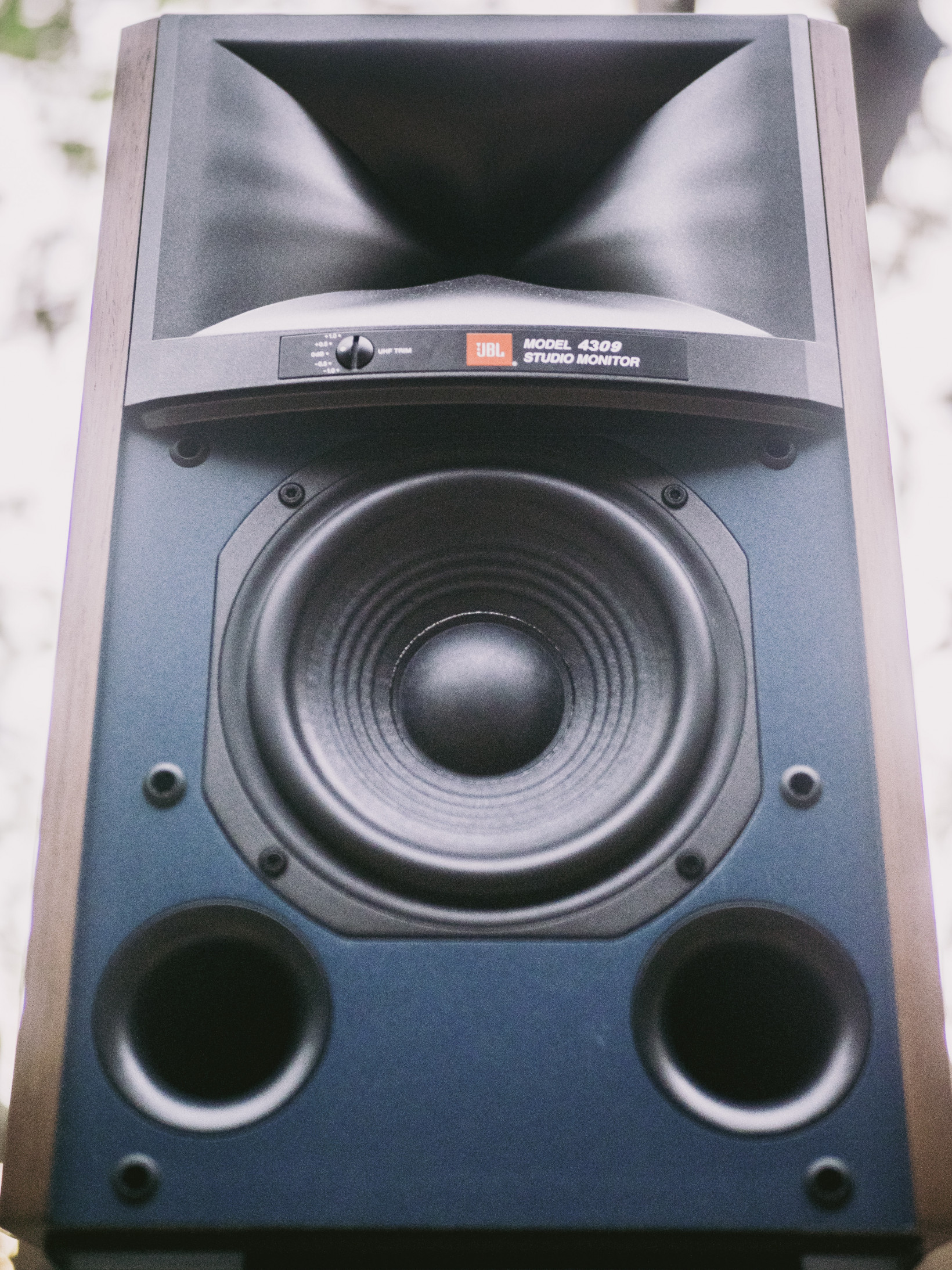
I will say right away that I’m immediately biased towards the 4309’s retro aesthetics. What can I say? I live in Brooklyn, and it fits the vibe.
Retro-ness aside, it also has a blue baffle and grille (there’s a black version too) and I’m a sucker for blue speakers. There should really be more of them.
The speakers feel solidly built, and I like how the grille only covers the more vulnerable woofer. Usually, grilles are detrimental to sound quality, but I could not hear the difference with the 4309. The compression driver is safely tucked away at the rear of the horn, so it doesn’t need the added protection.
As a bit of a throwback bonus, the 4309s also include a high-frequency adjustment knob that is rarely found on modern speakers. It only has a range of +/- 1 dB, but that can be the difference between a speaker sounding too bright or too dull in some homes. You could of course always apply EQ elsewhere, but it’s nice to have dedicated controls on the speakers.
A few words about my review style: I try not to shower speakers with vague superlatives. There are plenty of other reviews for that. In my mind, what defines a good speaker isn’t the presence of ineffable euphonic qualities, but rather an absence of audible flaws. In some ways, the better the speaker, the less I have to write about.
I also believe in the usefulness of speaker measurements and prefer to test products that seemingly adhere to the best science we have on acoustics. That is, speakers with a flattish frequency response and smooth directivity. Not every speaker needs to be ruler flat, but unless there’s a really good reason for deviating, research suggests that speakers with these qualities are both the most accurate and the most likely to be enjoyed by listeners. That same research also tells us our tastes aren’t as nearly as unique as people tend to assume.
I always listen to a speaker before measuring when possible, but my listening notes tend to correlate very closely to measured data, so it makes sense to talk about them together.
On that note, let’s look at how the JBL 4309 performs when put through my test setup. The graph below is called a spinorama (also known as the CTA-2034A standard), so-called because one has to spin a speaker around to capture the sound at 70 different angles.

I explain what these lines mean and how they are calculated in the spinorama section of my measurements guide, but we can focus on a few key things here.
There are two primary things that dictate a speaker’s sound. There is the direct sound that travels in a line of sight from the speaker to your head. Then there is the sound the speaker radiates in all directions, which gets reflected off your walls and eventually reaches your ears. You need good performance in both respects in order to achieve truly exceptional sound.
Like most speakers following evidence-based design, the 4309’s sound is overall, quite neutral and transparent. In a way, much of the following assessment is splitting hairs, but, well, that’s just what audiophiles do.
Let’s evaluate the ‘direct’ sound first represented by the white (listening window) and green (on-axis) lines in the spin. I tend to focus on the listening window, as it’s an average of a few measurements that more realistically represents how the speaker is likely to be perceived. Ideally, this would be a flattish line, especially between roughly 200 Hz to 10kHz. The 4309 is mostly flat, with a few notable colorations.
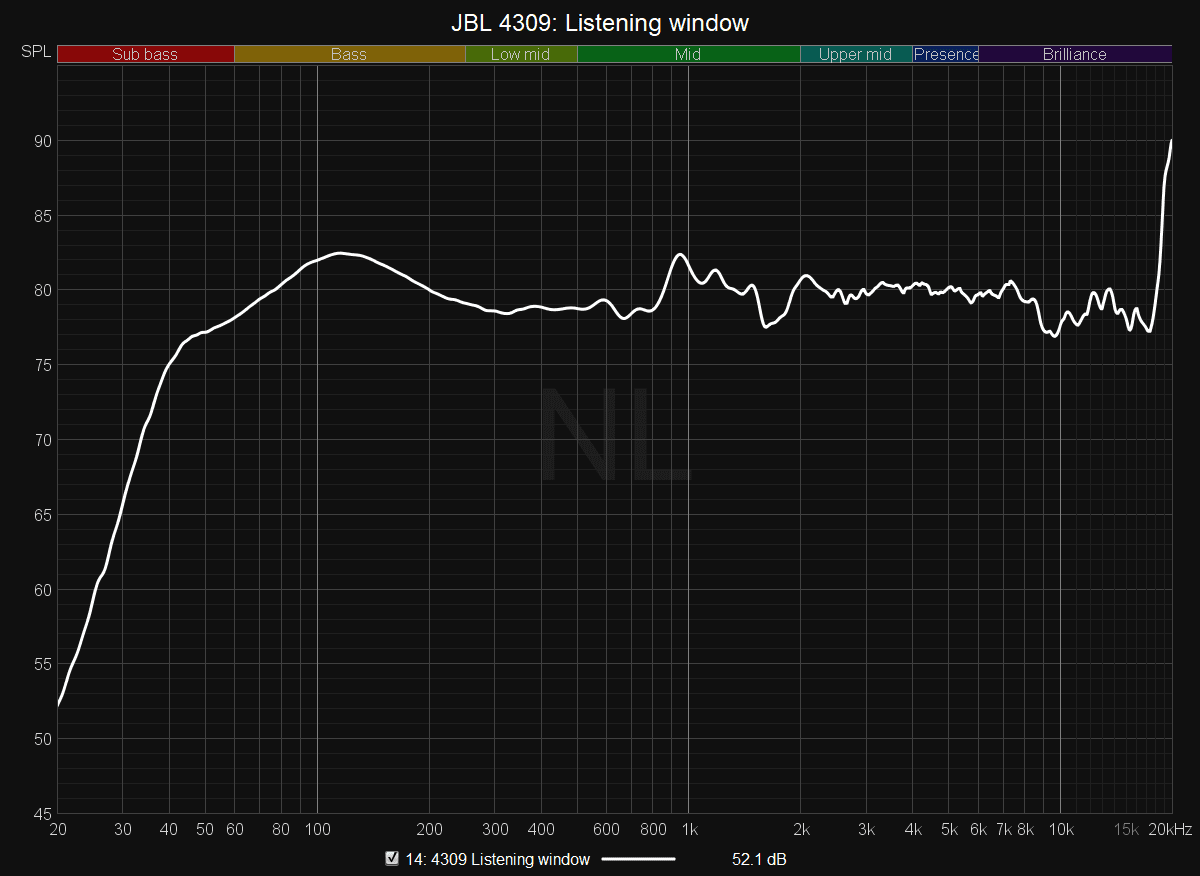
Like the HDI-1600, the 4309 does have a slightly emphasized bass. This isn’t a bad thing in my eye, especially in bookshelf speakers, which almost never extend all the way into the sub-bass. That said, there is a solid amount of bass extension here, comfortably audible to about 40 Hz in room.
On the other hand, the bass emphasis in the 100 Hz region means you probably won’t want to keep the speaker too close to your front wall or corners (unless you’re using EQ) lest the bass become truly excessive.
The rest of the frequency range is nicely neutral. There’s a bump around 1 kHz and a dip around 1.8 kHz — right in the middle of the midrange, but they are narrow enough that I did not find them to be highly audible (small dips don’t tend to be very audible anyway). Your mileage may vary, and ideally, this flaw wouldn’t be there, but sometimes deviations are less audible than they look.
Next we can look at the purple line — that’s the predicted in-room response. This weighs all 70 angles of the spinorama to predict how a speaker will perform in a typical living room setup. This should also look like a flattish line, except tilted downwards, and for the sake of the soundstage, it should roughly follow the shape of the listening window. (The PIR is almost always very similar to the blue ‘early reflections’ curve, so the former is often omitted from the spinorama).
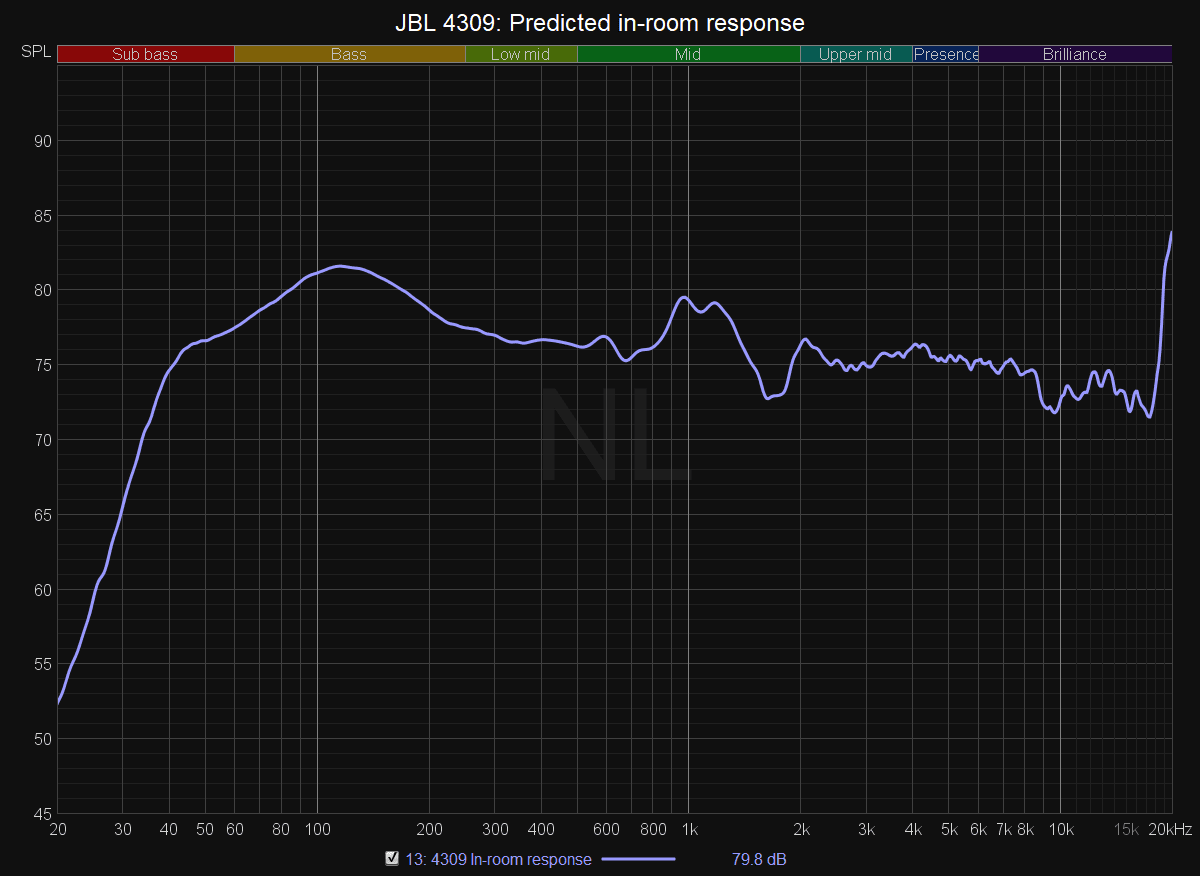
Here we do mostly get that, except the messiness in the mids is more pronounced. But again, I did not find this to be as audible as it looks — perhaps there was a slight messiness to the mids, but nothing that stood out to me as distracting or flat out ‘bad.’
All in all, it’s a very solid performance, and something very close to neutral. The main aspects of tonality that stood out to me were the slightly exaggerated bass and perhaps a slightly lean-ness around the lower mids. The lower mids are about a decibel or two below the upper mids and treble, which seemed to give the speaker’s a ‘dryer,’ slightly cooler sound. I didn’t mind it though; a little spice here and there isn’t always the worst thing.
Here I should also reiterate the speaker’s huge similarity with the HDI-1600; their measurements largely match each other, with the most notable difference being the 4309’s dip at 1.8 kHz. The latter might be a hair brighter too.
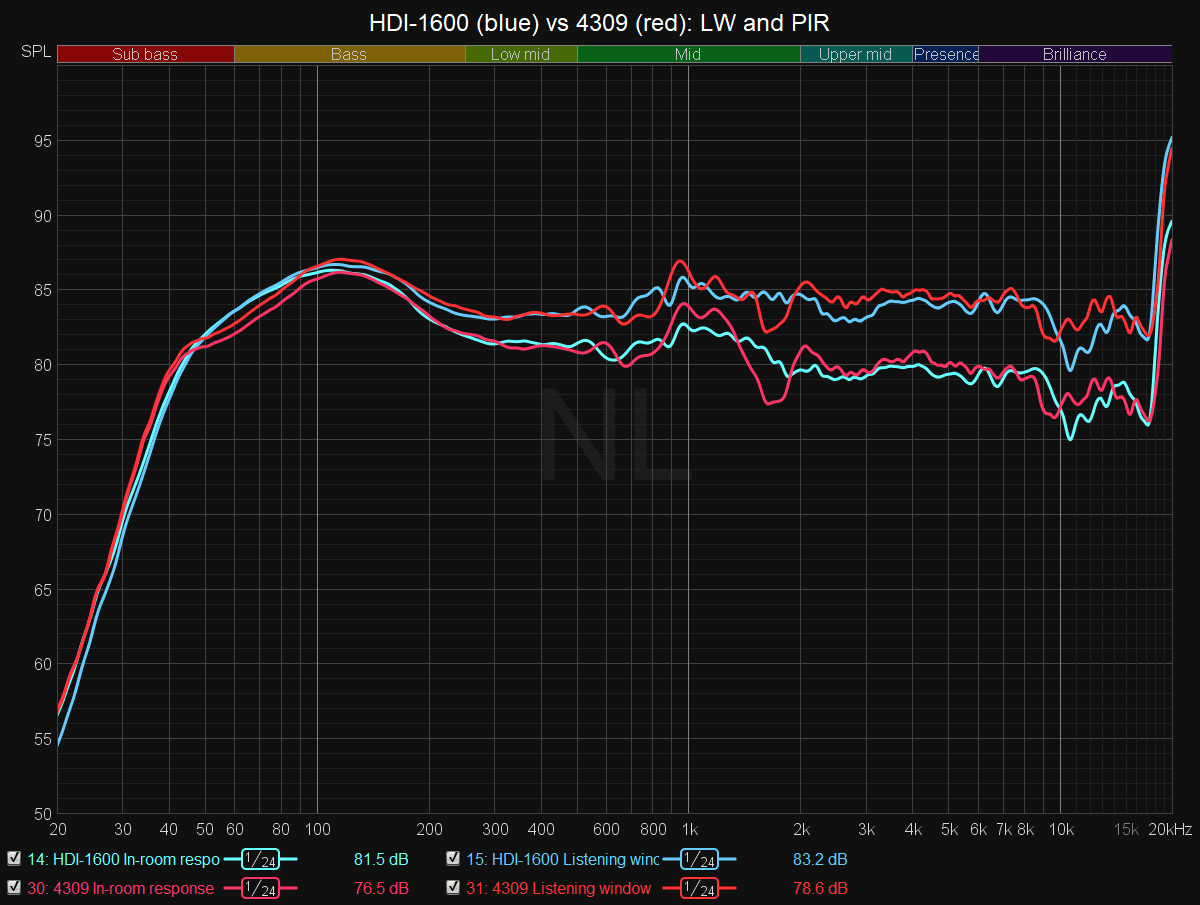
While the differences would likely be noticeable in a direct comparison, you’d pretty much getting the same class of speaker here.
Next we take a deeper look at directivity — how the speaker radiates sound in all directions. Remember, both the direct and reflected sound affect what we hear, and it’s the relationship between the two that largely defines a speaker’s soundstage performance. We want the reflected sound to closely match the direct sound. If it doesn’t, not only will tonality be affected, but the soundstage will become muddy too.
The blue line at the bottom of the spinorama, the ‘directivity index’ and ‘early reflections directivity index’ tells us about the speaker’s directivity. Ideally these would be smooth rising lines, and here we almost get that — except for, again, those deviations between 1-2 kHz.
However, one problem with the spinorama is that it doesn’t separate horizontal and vertical directivity. The former is much more important for soundstage performance, and as such very few speakers are optimized for the latter.
The yellow dotted line in the above spinorama, the ‘horizontal ERDI,’ uses only the horizontal component of the above ERDI. It is not an official part of the spinorama standard, but I include it because I find it is a better predictor of soundstage performance. Here we do see a smoothly rising line which is right up there with the best I’ve tested.
We can further break things down to see how the spinorama standard predicts reflections off the walls in front, to the side, and to the rear of the speaker.
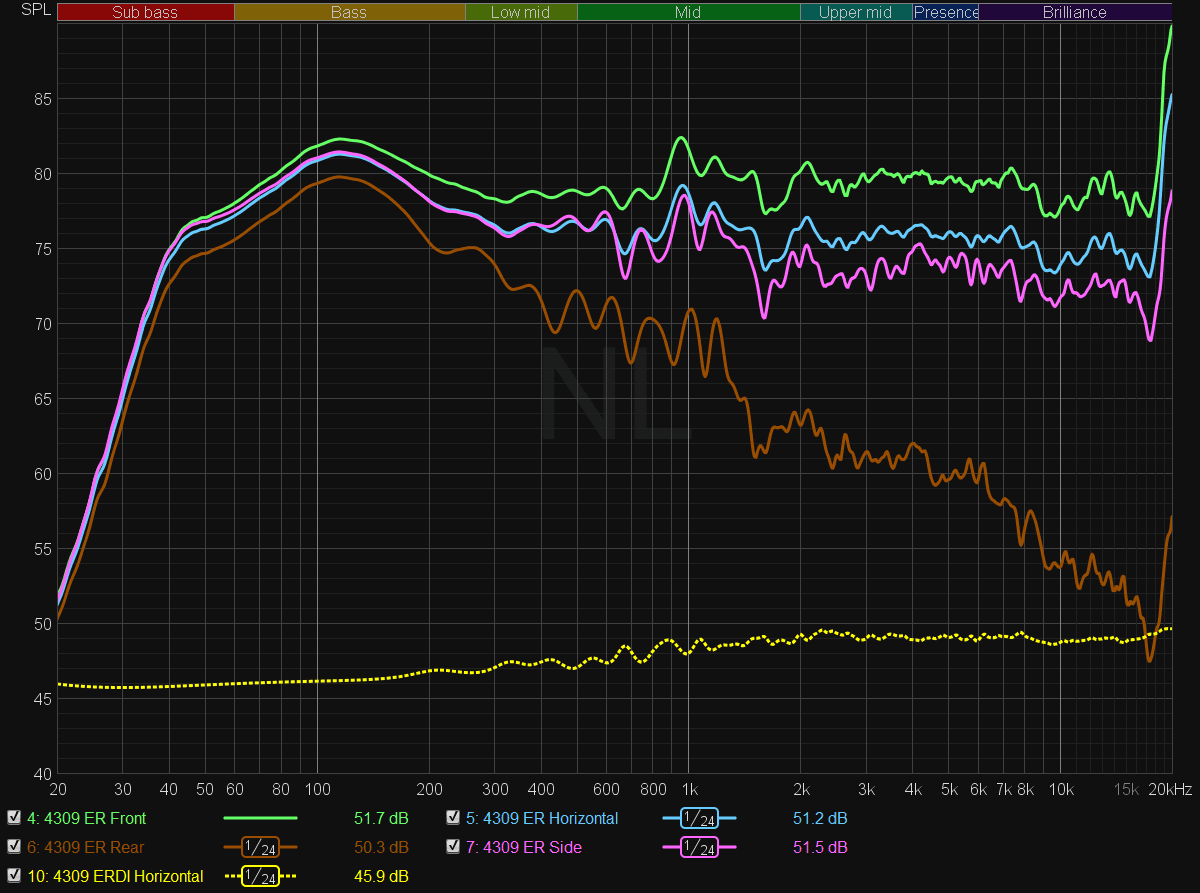
We want these curves to closely follow the shape of the listening window with varying degrees of tilt; the idea is that the more similar the reflections are to the direct sound, the more accurate and pleasant a speaker’s soundstage will be.
The sidewall reflections — the pink line above — are arguable the most important of these reflections, and the performance here is fantastic.
We can further break things down by looking at how the horizontal sound changes at 10-degree intervals; we want the shape to change smoothly at each step (as opposed to showing a large new dip or peak).

And that is what we get.
Speakers are always an exercise in compromise, and designers have to choose between having a very expansive sound that might sound a little diffuse, and having a narrower soundstage that has pinpoint imaging. While there’s no hard and fast rule for what constitutes ‘wide’ and ‘narrow’ directivity in a speaker, the JBL 4309, like the HDI-1600, trend a little towards the latter among bookshelf speakers I’ve tested (by comparison, the JBL L82 and Focal Chora 806 are more on the ‘wide’ side).
This is great if you want speakers that present instruments in a very precise manner, such that you could almost point to where exactly the sound is coming from with a laser. Which type of soundstage is best is largely a matter of taste and how the speaker interacts with your room and setup. I tend to prefer the more expansive presentation, but the 4309 is not crazy narrow, and I found it presented one of the most realistic spatial image of any speaker I’ve tested.
In terms of spatial presentation, I actually felt I enjoyed it a little more than the HDI-1600, and I think it measure a little better too. That, combined with my aesthetic preference for the retro model, means the 4309 is the speaker I’d personally choose.
While the vertical response is not as important, it can still color the sound. Two things I like to focus on are whether a speaker is sensitive to vertical positioning by measuring at a few degrees above and below the speaker. We can see that being up 10 degrees above or below the tweeter does not majorly affect the speaker’s sound:
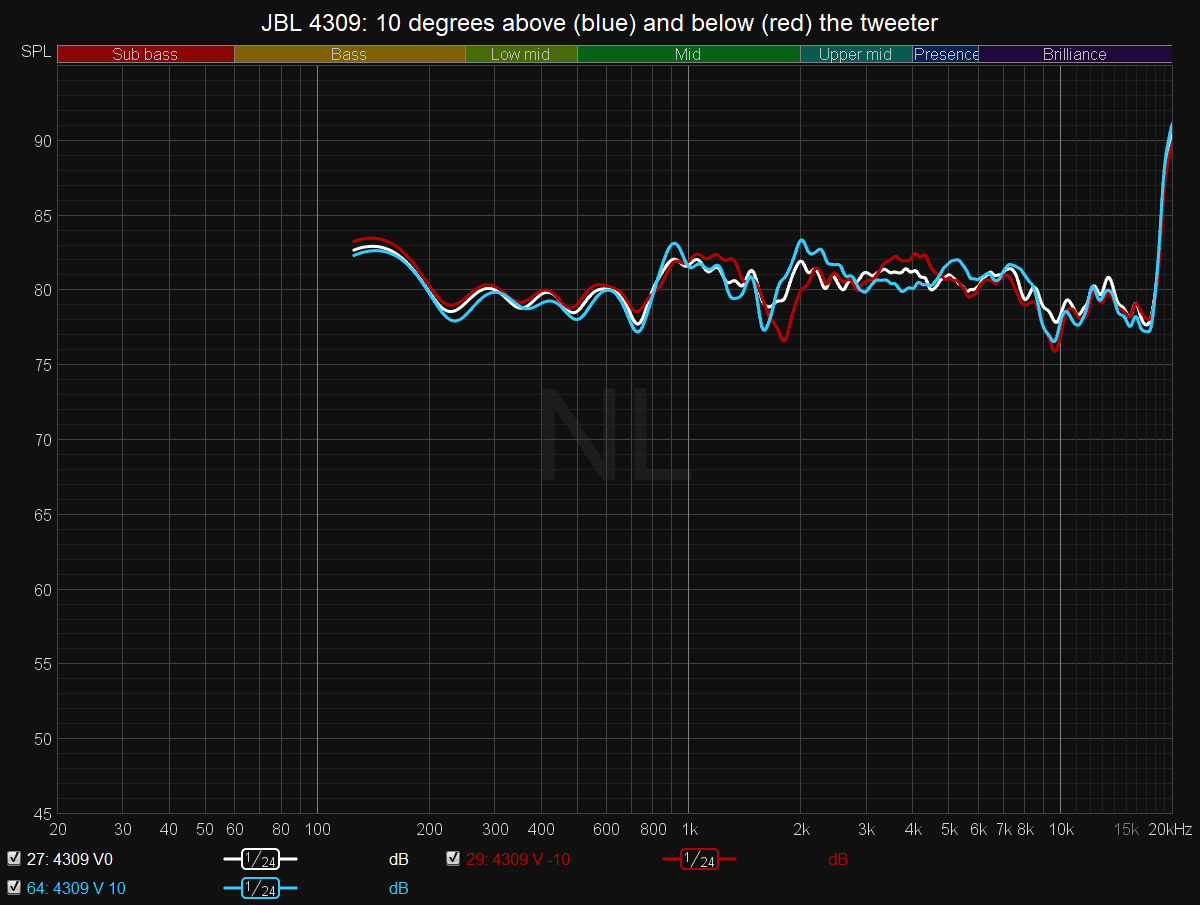
Then I like to see how the estimated ceiling and floor reflections look:
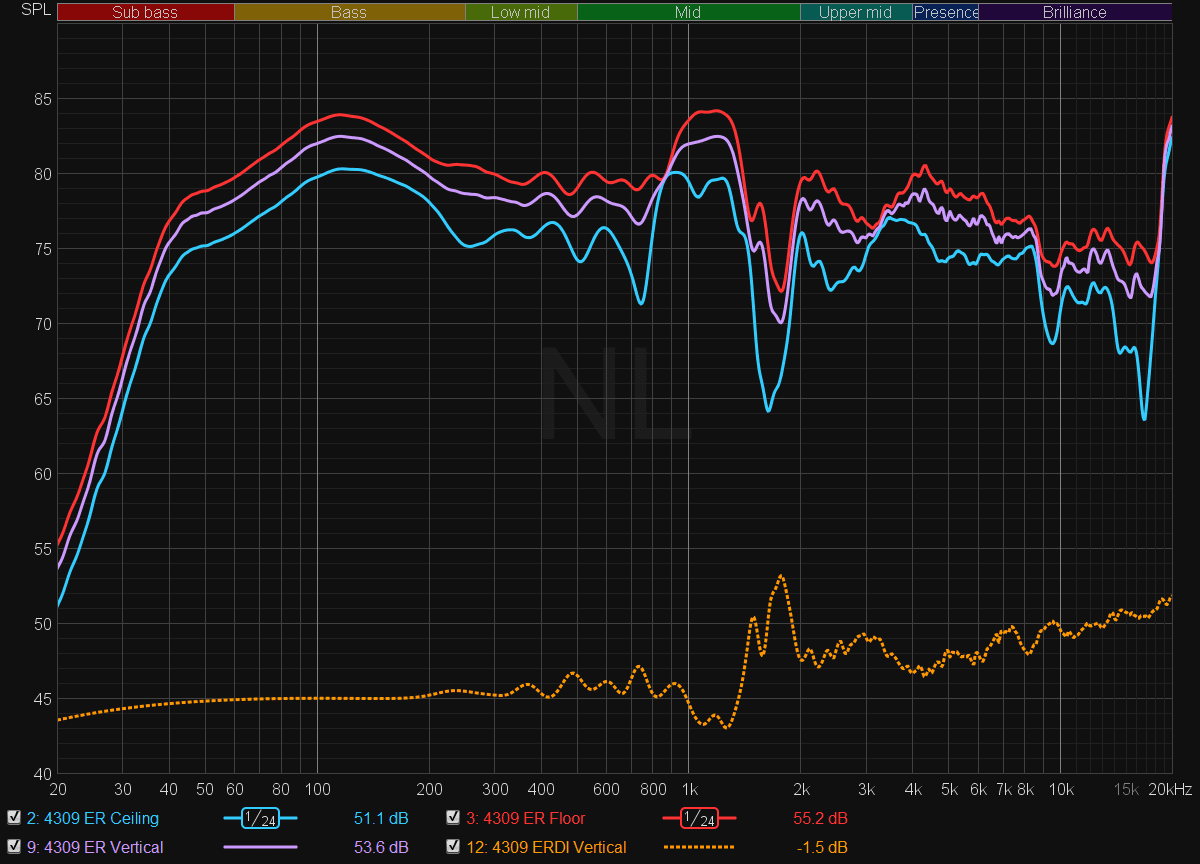
Here’s where we see the speaker’s flaws, but vertical problems are present in the vast majority of speakers. This is pretty decent as far as these types of issues go.
A couple of miscellaneous measurements follow. Here’s how the high-frequency knob affects the speaker’s sound at its maximum and minimum levels.
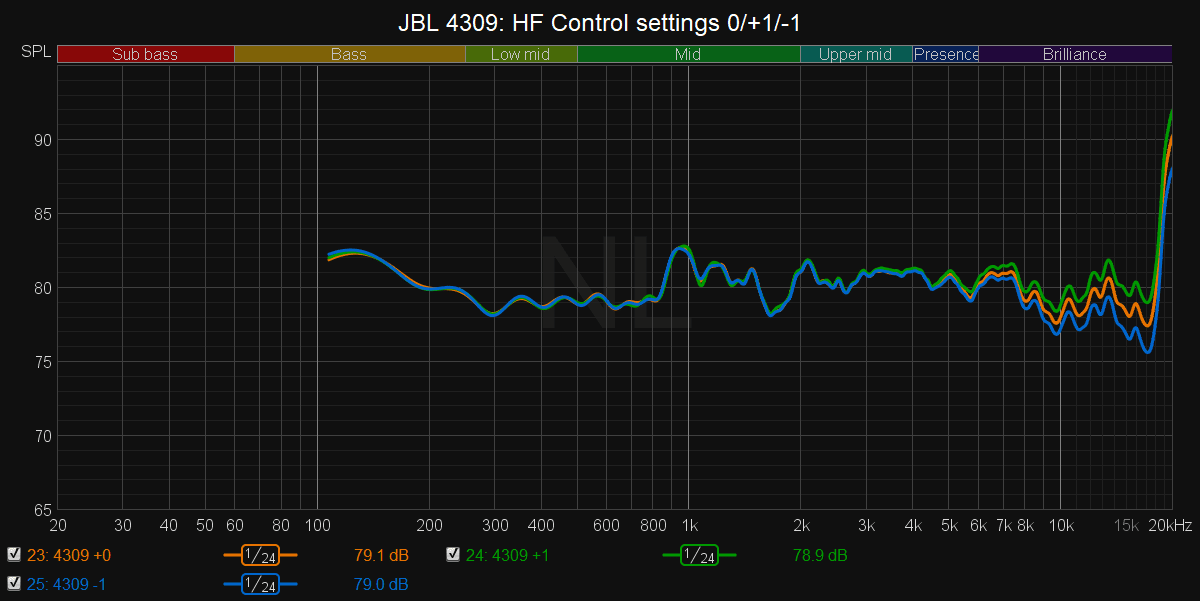
We can see it only really has an impact above 5 kHz, but it’s enough to be audible provide valuable tuning characteristics. I found the default tuning just fine.
And lastly, we can see that the grille has a negligible impact on the sound:
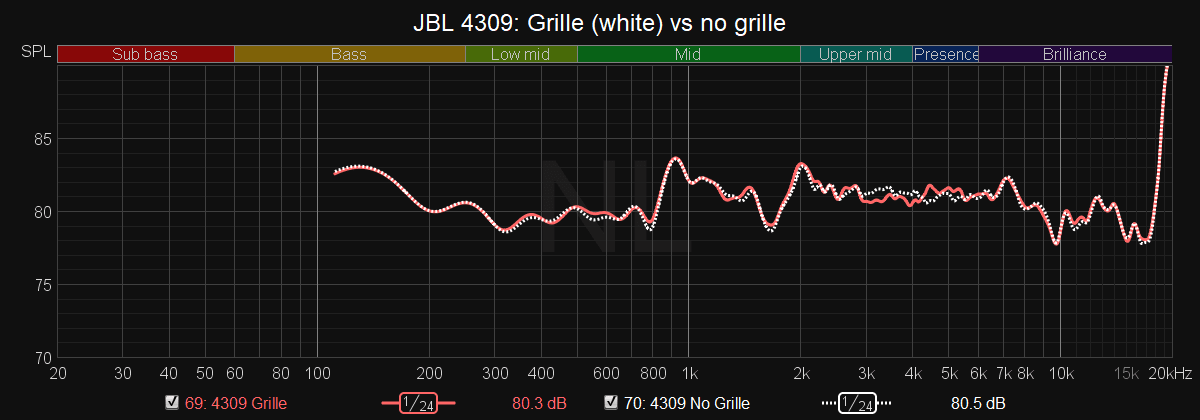
I know, that was a lot, but it tells us most of what we know about the speaker’s sound.
Something the above measurements don’t quantify are the speakers’ dynamics and ability to play loud. To that, I’ll just say the speakers can handle me cranking up the volume far higher than I’m comfortable maintaining in an apartment setup. Like the HDI-1600, they don’t seem to hold anything back when played loud, something which can likely be attributed to the horn and compression driver.

What else can I say? The 4309 is another example of JBL’s excellent speaker design. While there are some blemishes, I believe these are unlikely to be problematic to most users, and many will even enjoy the slightly boosted bass.
If you’ve got $2000 to spend on speakers and want something that sounds neutral, can play loud, and has a pristine spatial presentation — not to mention a retro design that can boost your hipster cred — the JBL 4309 should definitely be on your radar.
Get the TNW newsletter
Get the most important tech news in your inbox each week.
